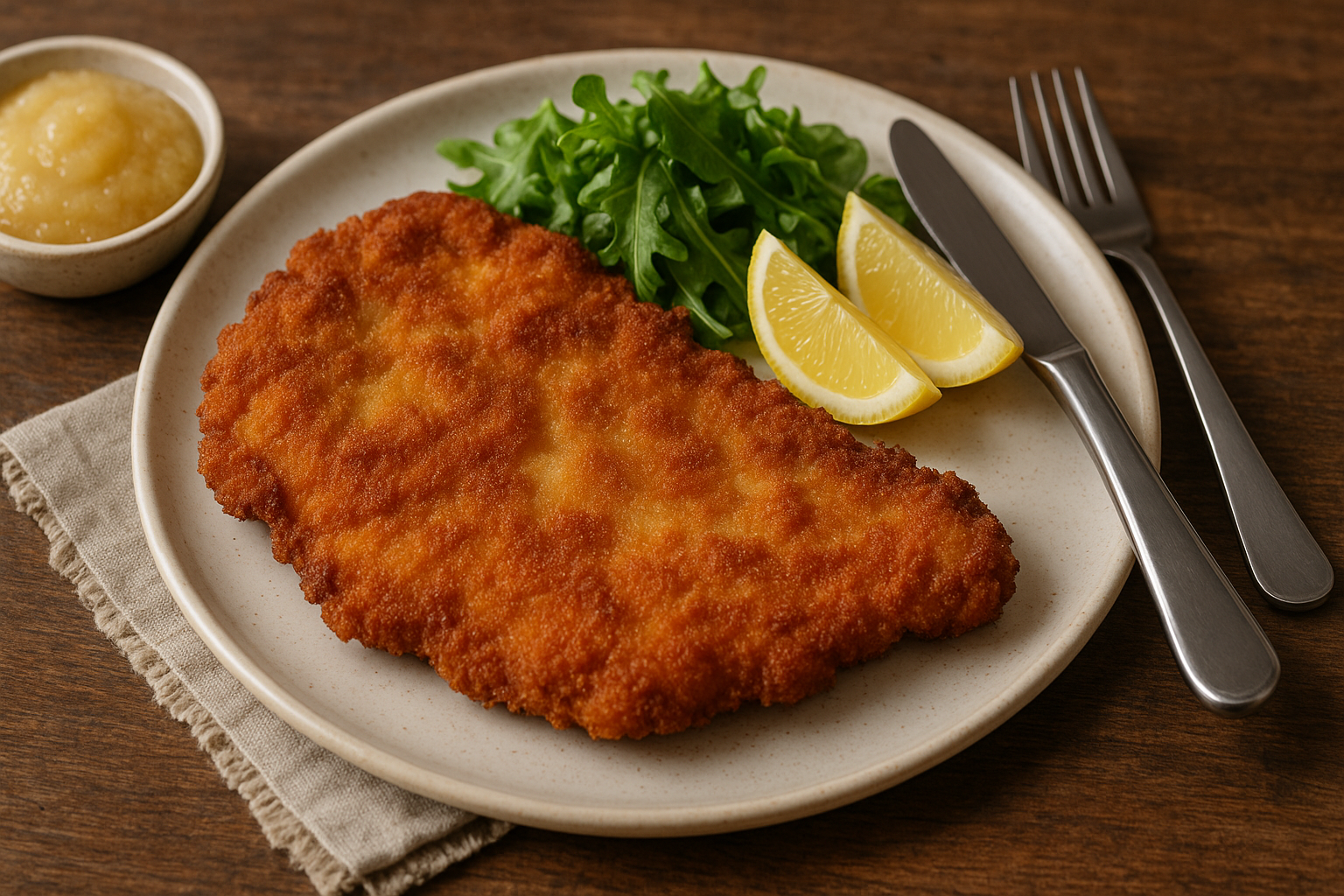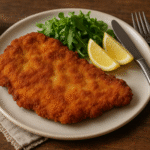Introduction to the Classic Schnitzel Recipe
A good schnitzel recipe never goes out of style. Crispy, golden, and tender, this beloved dish has been satisfying appetites for generations across Europe and beyond. Whether made with pork, chicken, or veal, schnitzel is one of those timeless comfort foods that combines simplicity with rich, satisfying flavor.
The beauty of a schnitzel recipe lies in its versatility. It can be enjoyed as a hearty main dish for family dinners or served as a special weekend treat. With just a few ingredients and the right techniques, anyone can master the art of making schnitzel at home. This guide will walk you through everything from preparing the meat to achieving that perfect crispy crust.
Essential Ingredients for a Perfect Schnitzel
Every delicious schnitzel recipe starts with fresh, high-quality ingredients. The main component is the meat, traditionally veal for Wiener schnitzel, though pork and chicken are equally popular. Choosing thin cuts ensures tenderness and quicker cooking.
Flour, eggs, and breadcrumbs create the iconic coating that gives schnitzel its satisfying crunch. Use all-purpose flour for dusting, beaten eggs to bind, and fine breadcrumbs for a uniform golden crust. For extra crispiness, some cooks prefer using panko breadcrumbs, which create a lighter texture.
Salt and pepper bring out the natural flavors of the meat, while lemon wedges add a touch of freshness when serving. Neutral oil, such as sunflower or canola, is ideal for frying since it handles high heat well without altering the taste.
The simplicity of these ingredients is what makes the schnitzel recipe so approachable. Each element plays an important role in balancing texture and flavor, giving you that classic European taste every time you cook it.
Step-by-Step Guide to Making Schnitzel at Home
Making schnitzel at home is simple once you understand the basic flow. Start by laying your meat pieces flat on a clean surface and gently pound them until they are about a quarter-inch thick. Thin pieces cook evenly and stay tender inside.
Next, prepare three shallow dishes for your coating process: one with flour, another with beaten eggs, and the third with breadcrumbs. Coat each piece of meat lightly with flour, then dip it in the egg mixture, and finally press it into the breadcrumbs until evenly covered.
Heat oil in a large pan over medium-high heat. The oil should be hot enough that the schnitzel sizzles immediately when placed in the pan. Fry each piece until golden brown, turning once to ensure both sides cook perfectly. This usually takes two to three minutes per side, depending on thickness.
Once cooked, transfer the schnitzel to a paper towel-lined plate to absorb excess oil. This step keeps the coating crisp while preventing it from becoming greasy. Serve warm with lemon wedges or your favorite sauce for a restaurant-quality meal at home.
How to Properly Prepare and Tenderize the Meat?
The secret to a great schnitzel recipe lies in how you prepare the meat before cooking. Tenderizing is essential because it ensures the schnitzel cooks evenly and remains juicy. Use a meat mallet to gently pound the meat until it’s uniformly thin, but be careful not to tear it.
If you’re using veal, choose cuts from the leg for their tenderness. For chicken schnitzel, boneless breasts work best, while pork lovers should select boneless loin chops. The goal is to achieve a thin, tender cut that cooks quickly and evenly.
Seasoning the meat lightly before coating helps build flavor from the inside out. A simple sprinkle of salt and pepper on both sides is often all that’s needed. Once the meat is seasoned and flattened, it’s ready for the coating process that gives schnitzel its signature crunch.
This careful preparation makes a noticeable difference in the final result, producing schnitzel that’s crisp on the outside and soft on the inside — the perfect balance every cook aims for.
Frying Techniques for Golden and Crispy Schnitzel
The frying process is where your schnitzel recipe truly comes to life. Heat the oil until it’s shimmering but not smoking — around 350°F (175°C) is ideal. The right temperature ensures the coating becomes golden and crisp without absorbing too much oil.
Avoid overcrowding the pan. Fry one or two pieces at a time so the oil temperature stays consistent. When the schnitzel is ready to flip, you’ll notice the edges turning a rich golden color. A gentle turn with tongs ensures even browning on both sides.
For the best texture, keep the oil level high enough to allow the schnitzel to float slightly. This helps it cook evenly and develop that light, crisp finish. If you prefer a lighter version, you can shallow-fry instead of deep-frying — just make sure to adjust the cooking time.
When done, transfer the schnitzel to a rack or paper towel to drain excess oil. Letting it rest for a minute or two before serving helps maintain that perfect crunch.
Best Side Dishes and Sauces to Serve with Schnitzel
A schnitzel recipe feels complete when paired with the right side dishes and sauces. Traditional accompaniments include potato salad, mashed potatoes, or crispy fries, which balance the schnitzel’s richness beautifully. A light cucumber or cabbage salad can also add a refreshing touch.
Sauces enhance the flavor of the schnitzel without overpowering it. Lemon wedges are the simplest and most traditional option, adding a bright, tangy note. Mushroom gravy, creamy dill sauce, or even cranberry sauce can complement the dish nicely depending on regional traditions.
If you prefer a lighter meal, serve schnitzel with steamed vegetables or a fresh green salad. For a heartier dinner, pair it with roasted potatoes or buttered noodles. The key is to create a balance between crispy and soft, rich and refreshing.
These pairings make schnitzel versatile for any occasion — from casual family meals to festive gatherings.
Tips and Common Mistakes to Avoid When Cooking Schnitzel
Even a simple schnitzel recipe can go wrong if a few key details are missed. One common mistake is using thick cuts of meat, which can result in uneven cooking. Always pound the meat thinly for the best results.
Another error is frying at the wrong temperature. If the oil is too cool, the schnitzel will absorb it and turn soggy. If it’s too hot, the coating will burn before the inside cooks. Keeping the temperature consistent is the secret to perfection.
Avoid pressing down on the schnitzel while it fries. This can cause the coating to break and lose its crisp texture. Also, never stack freshly fried schnitzels on top of each other; the trapped steam will make them soggy.
Finally, season lightly but evenly. Let the natural flavor of the meat and breadcrumbs shine through. These simple adjustments can make your schnitzel taste just like one from your favorite European restaurant.
Final Thoughts on the Schnitzel Recipe
The schnitzel recipe may be simple, but its charm lies in its balance of crispiness, tenderness, and timeless flavor. From the careful tenderizing of the meat to the golden perfection achieved during frying, every step contributes to creating a meal that’s both comforting and satisfying.
Whether you stick to tradition with veal or experiment with chicken or pork, mastering the schnitzel recipe allows you to bring a touch of classic European cooking into your own kitchen. It’s a dish that never fails to impress — easy enough for beginners, yet elegant enough for special occasions.
Serve it fresh, golden, and warm, and you’ll understand why schnitzel continues to be loved around the world. With the right technique and attention to detail, your homemade schnitzel can easily rival any restaurant version.
My name is Mustafa, and I have been blogging for over 5 years. I am passionate about sharing complete, accurate, and helpful information with my readers. Along with managing content on The Matcha Read, I also contribute blog posts to premium websites. My goal is to provide valuable insights in a clear and easy-to-understand way, so every reader walks away with useful knowledge.










